NATIONAL ZOO AND CONSERVATION BIOLOGY INSTITUTE
School is in Session for Clouded Leopard Cubs
Get a sneak peek into one very important aspect of clouded leopard cubs’ daily care at the Zoo: training.
:focal(749x329:750x330)/https://tf-cmsv2-smithsonianmag-media.s3.amazonaws.com/blogging/featured/20191002_003eb.jpg)
When clouded leopard cubs Jilian and Paitoon made their debut at Asia Trail last September, it was a historic moment. Although the Smithsonian’s National Zoo has exhibited this rare cat before, they were the first cubs to serve as (adorable) ambassadors for their species. Our entire team was excited to educate visitors about our new residents and inspire them to care about this species, which colleagues at the Smithsonian Conservation Biology Institute have been studying for decades. Their cutting-edge breeding research over the years has done a lot to ensure the conservation of these cats, both in zoos and in the wild. Jilian and Paitoon are just two of many reproduction success stories.
Most visitors, however, don’t get a chance to see all of the effort to provide excellent care that goes on behind the scenes. We’d like to give you a sneak peek into one very important aspect of Jilian and Paitoon’s lives here at the Zoo: training. Our enrichment and training program gives the Zoo’s animals an opportunity to participate in their own healthcare, get some physical and mental exercise, and helps to build trust between the cubs and us, their keepers.
Before we dive into that, though, we want to introduce you to the cubs!
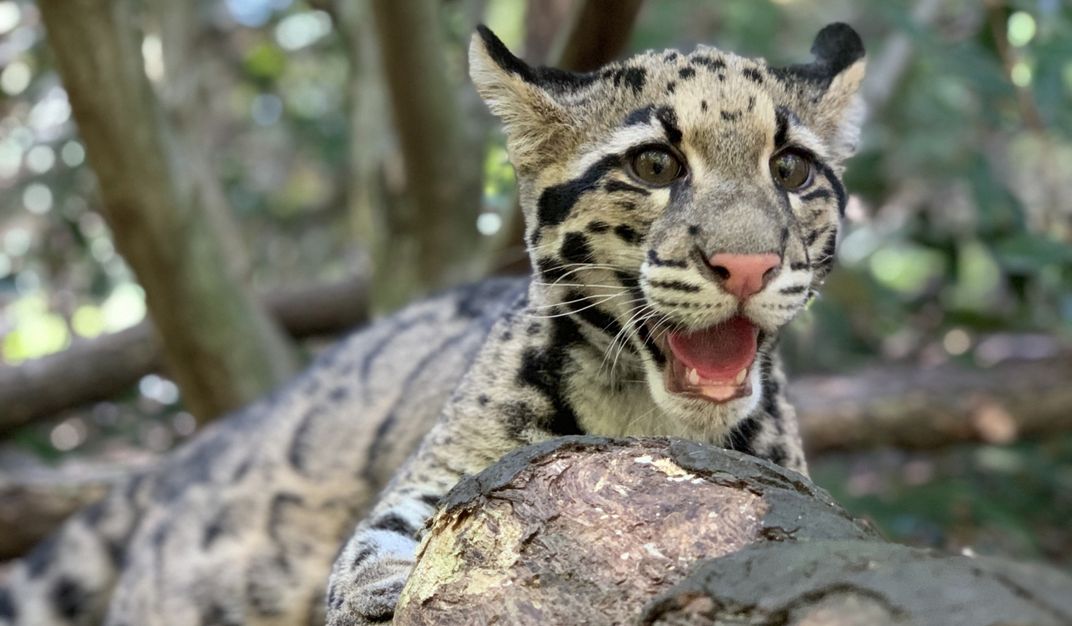
First up, meet Jilian. She is super playful and curious. To get our attention, she will vocalize with a friendly “chuff” and brush up against the mesh of her enclosure. One of the best things about training Jilian is how amped up and excited she is to participate. She will hop up on her rear legs and toss her head back, looking at us. Sometimes, she turns her head a little too far, and she loses her balance and rolls on her back. But, she always gets back up to train again.
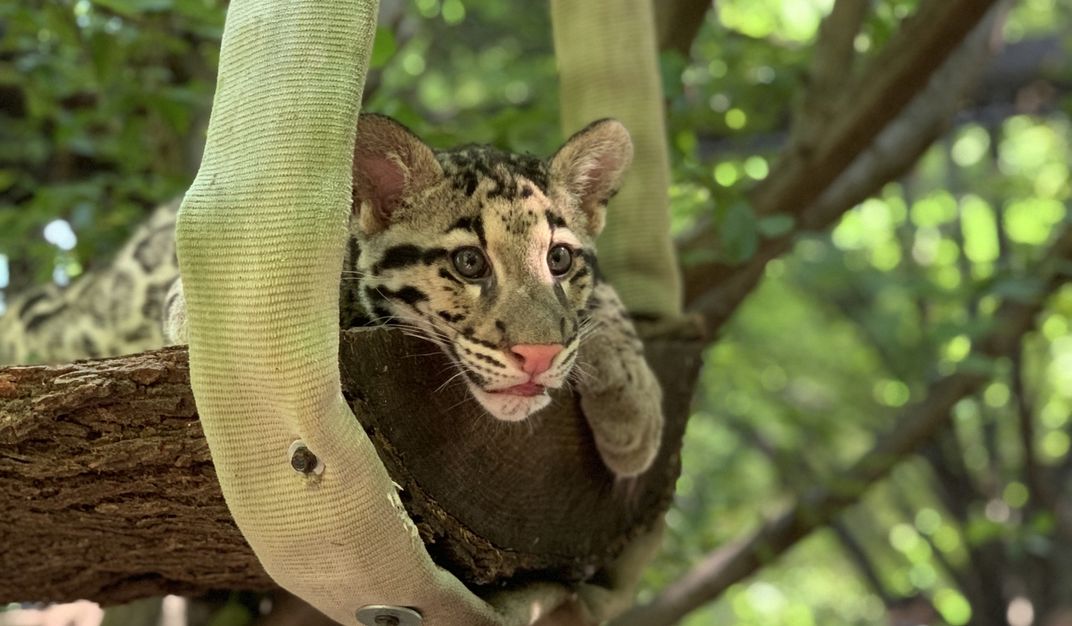
Paitoon is pretty laid back, though he isn’t afraid to let everyone know when he is hungry! Whenever he spots us from the perching in his outdoor habitat, he runs along the yard and chuffs at us. He can be a bit of a goof sometimes, but he’s very smart and a fast learner.
Every morning and afternoon, the cubs take part in husbandry training sessions where we teach them behaviors that enable them to voluntarily participate in their own veterinary care. This allows us to perform important procedures — including administering vaccines — while the cubs are awake. Not only does this reduce the need to use anesthesia for routine checkups, but also it makes the whole process a lot less stressful. It’s also a more positive experience for Jilian and Paitoon overall.
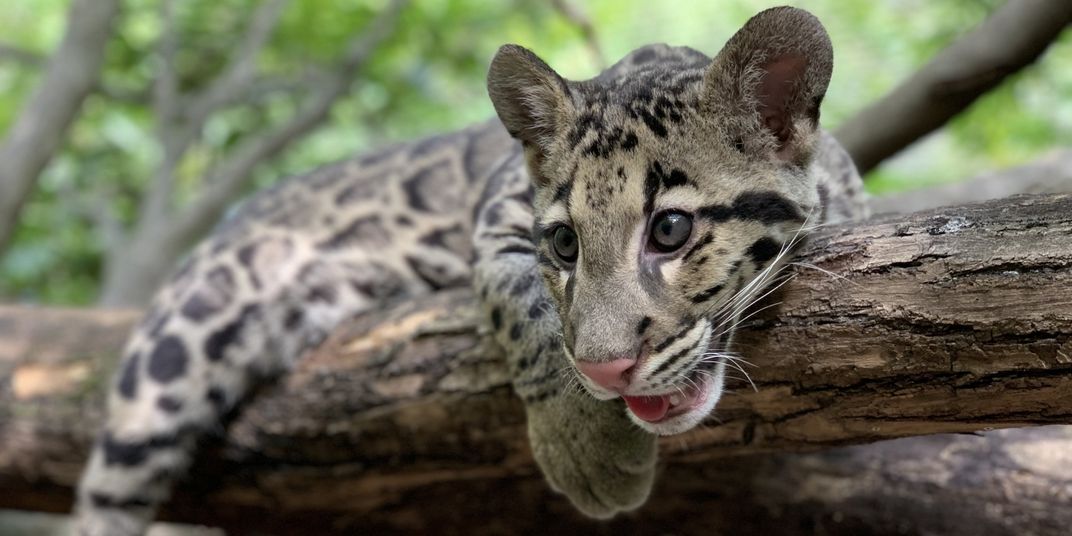
The cubs have established strong bonds with their keepers, so they are often eager to work one-on-one with us. Although we used to share the same space when the cubs were young, they are now at an age and size where all of our interactions with them are done through a barrier. In the zoo world, we call this “protected contact,” and it helps ensure that both animals and keepers stay safe.
Our program uses positive reinforcement, which means the cubs are rewarded with a favorite treat for doing the behavior asked of them. There are no negative consequences if they do an incorrect behavior or choose to walk away. These training sessions offer both a cognitive and social form of enrichment for the cubs. They have to figure out what behaviors we are asking them to do through trial and error. This requires some problem-solving skills. They also get a chance to socialize with us to shape said behaviors.
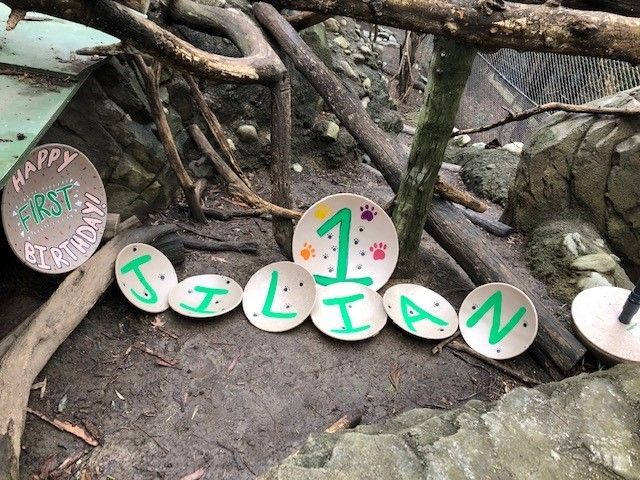
Both Jilian and Paitoon are very smart, eager to please and seem to enjoy their training sessions. We have been training them since they were around four months old, starting with easy behaviors and building up to more complex ones. Some of the behaviors that they have already mastered include touching their nose to a target, stepping on a scale for weekly weigh-ins, putting their paws up on the mesh so keepers can inspect their paw pads and vocalizing on command! The more behaviors the cubs can do voluntarily on cue, the more relaxed they are and the better we can meet all of their needs.
Over the past few months, we have been working closely with Jilian and Paitoon to voluntarily accept injections. This is important for preparing them for yearly vaccinations they will need, such as rabies and distemper. Not to mention that when it comes time for our veterinary team to do the cats’ routine physical examinations, it will be a safe and stress-free way to sedate them. Training complex behaviors such as this can take weeks, months or even years. The trick is to turn an experience that could be uncomfortable or scary into something positive and enjoyable.
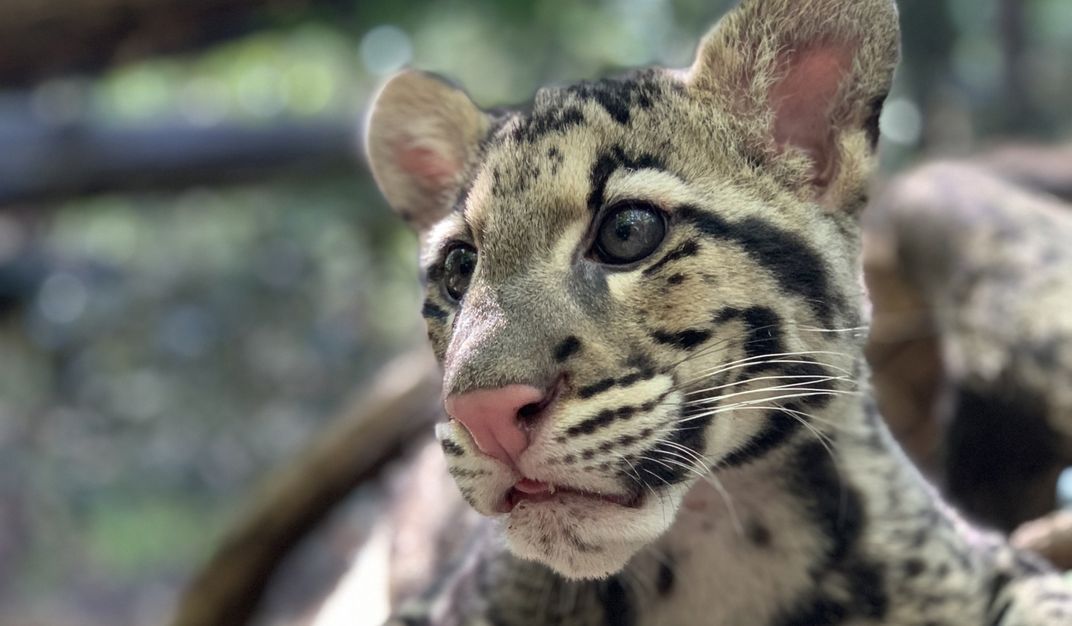
First and foremost, we had to ensure that Jilian and Paitoon were comfortable in the area where the training takes place. It’s colloquially referred to as a “squeeze,” though we don’t actually squeeze them during injection training sessions. Rather, this device has a back wall that can be pushed in a bit to temporarily restrict an animal’s mobility, if needed. We fed them as often as possible in this location so that they would associate the squeeze with a positive experience: mealtime.
The next step was for us to get them used to the sounds that the training squeeze makes. Knowing how sensitive and shy this species can be, our goal from day one was to expose these young cubs to as many new sights and sounds as possible. We would jiggle the door to get them used to the noise and would slowly close the door behind them. Initially, we only closed it for a second or two before reopening it. Gradually, we worked our way up to longer periods.
Once the cubs showed they were relaxed enough to be closed in the training squeeze, a second keeper entered the stall adjacent to them. As long as the cats focused on the keeper feeding them, the second keeper was able to lightly touch the cub at the injection site. As training progressed, we upgraded from a simple touch with our fingers to the blunt end of a paperclip, simulating the prick of a needle.
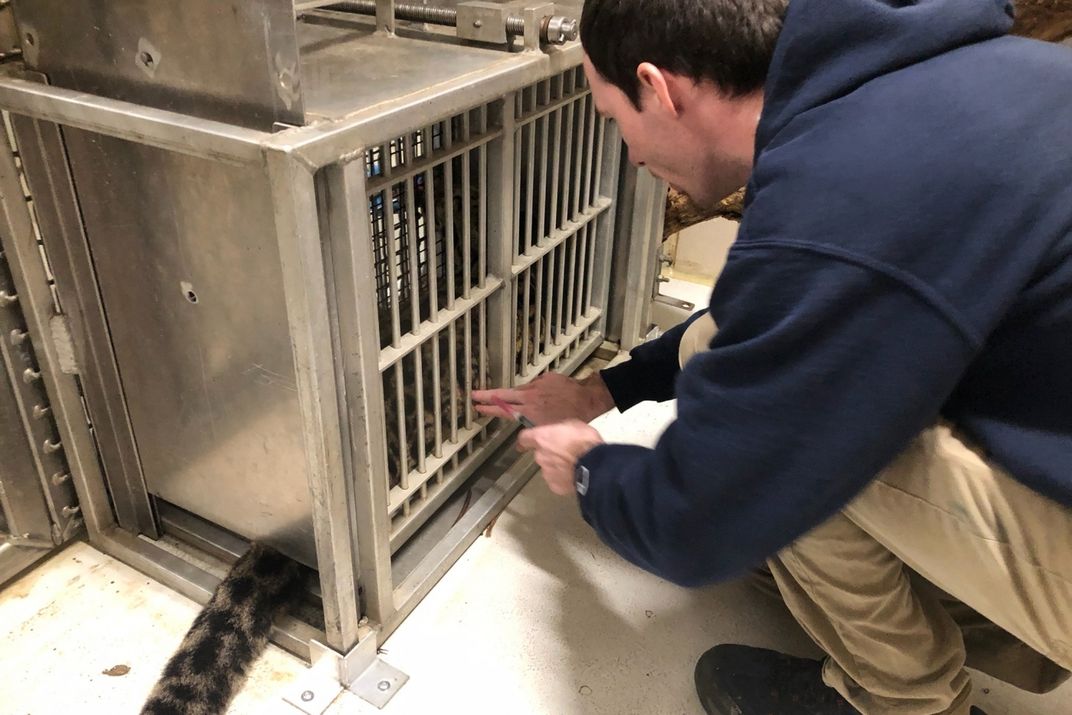
After a few trials with no negative reactions, we invited two of our veterinary technicians to observe and participate in the training. We adhere to strict guidelines for the safety of our animals and receive training from our veterinary staff before we are able to use a needle ourselves. Although we keepers can use actual needles to habituate the cubs to the feeling of the needle pricks, a veterinarian or veterinary technician must administer the vaccines on vaccination days.
With the leopards’ shy and skittish nature, loud noises and strangers can make this training a little challenging. Having our vet techs present from early in the training process helps desensitize the cats to a third, unfamiliar person. As long as the cubs continue to willingly participate, we gradually increase the needle size so we can be ready for vaccination day.
We typically practice injection training four times a week — twice with keepers, and twice with vet techs. Paitoon always trains first because he demands it! He is much more food motivated than Jilian. His favorite thing to do in the world seems to be eating. He will eagerly train for his normal diet of raw meatballs. If we tried to train Jilian first, he would yell until he got his way. That would be very distracting to Jilian and us, so he trains and receives his food reward first.
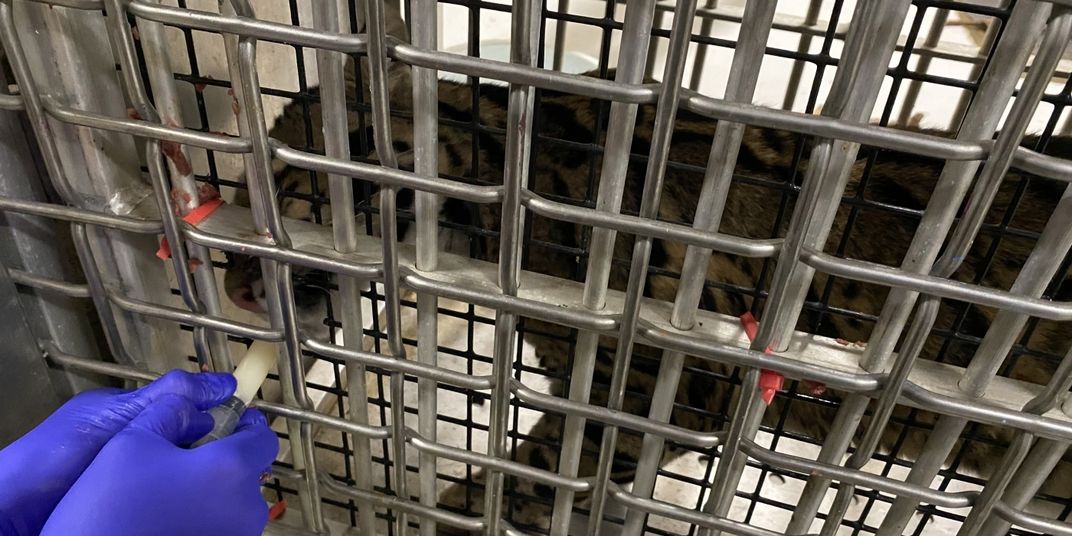
Jilian waits patiently in the adjoining enclosure until it is her turn. She wasn’t willing to train for her normal diet, so we worked closely with our Department of Nutrition Sciences to figure out what food would motivate her to participate. We offered different types of fish, meat, mice, chicken and chicken broth. In the end, the only thing she was willing to train for was goat’s milk. We dilute it with water and she happily laps it out of a syringe while sitting in the training squeeze. Jilian is still working on mastering this behavior, but we are pleased with the progress she has made so far.
The first time we were able to inject Paitoon with hardly any reaction at all was a very proud moment. The process took about two months, but now he looks forward to these training sessions. He comes bounding out of the yard when we call him for injection training and is usually waiting in the squeeze for us! In fact, he is ready for the next big milestone, which is blood draw training.
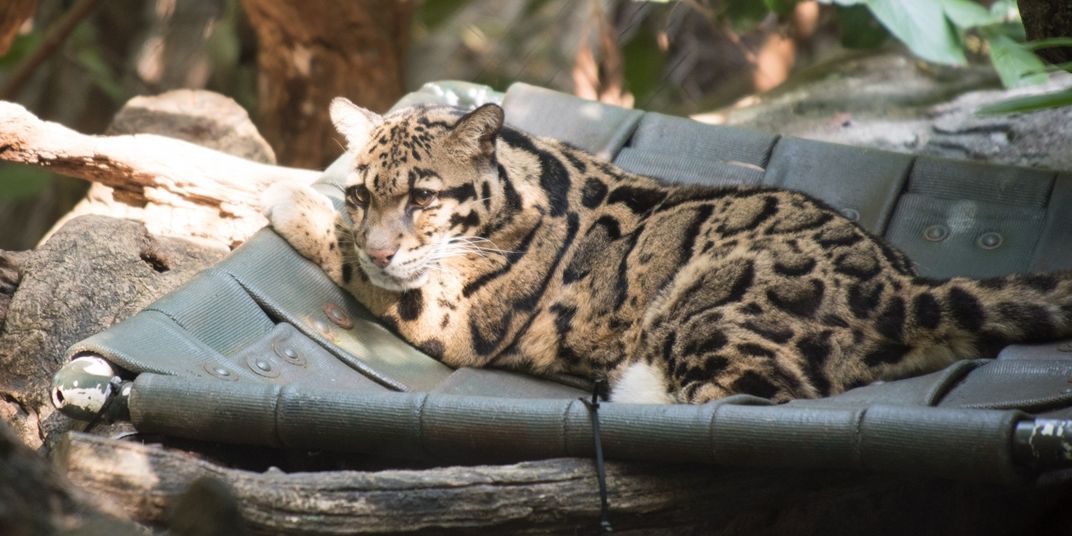
Visitors often ask us if the cubs ever share the habitat with Mook, our elderly female clouded leopard. The short answer is no. On average, clouded leopards live to be about 12 years old, but Mook is 18. In fact, she is the oldest of her species in the North American population. She would not appreciate having to entertain two young cubs, so while they cause trouble in the exhibit during the day, Mook takes advantage of the quiet, peaceful exhibit overnight and into the morning.
We hope that in watching Mook, Jilian and Paitoon, visitors realize just how beautiful, intelligent and special this species is. There are less than 10,000 of these cats left in the world. It is a struggle they share with many species. Deforestation in Indonesia directly impacts the deep forest habitats clouded leopards need to survive. One way to help clouded leopards is to practice sustainable shopping — only purchase products that are palm oil free or use sustainable practices. And, when traveling, seek out opportunities that allow you to observe wildlife while supporting conservation efforts that aid these and other endangered species. So much of what we do has an impact. The time to affect change is now if we hope to have clouded leopards around for generations to come.
This story was featured in the April 2020 issue of National Zoo News. Though the Zoo is temporarily closed to the public, keepers continue to provide the highest quality of animal care to all of its residents.
Want to help replenish toys, puzzle feeders and training tools that are a bit run-down yet well loved by the Zoo’s animals? Donate to the Enrichment Trunk. Your support directly benefits the animals at the Smithsonian’s National Zoo and Conservation Biology Institute.
